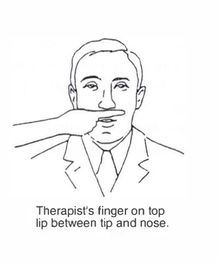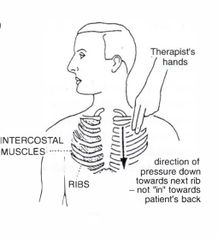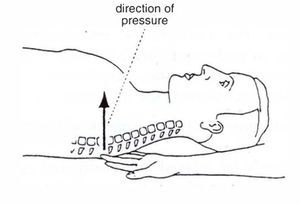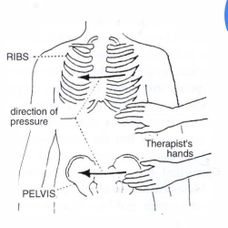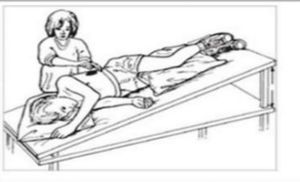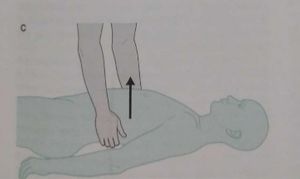Neurophysiological Facilitation of Respiration (NPF): Difference between revisions
Anas Mohamed (talk | contribs) No edit summary |
Anas Mohamed (talk | contribs) No edit summary |
||
| Line 11: | Line 11: | ||
# '''Intercoastal stretch''' | # '''Intercoastal stretch''' | ||
# '''Thoracic vertebral pressure''' | # '''Thoracic vertebral pressure''' | ||
# '''Co-contraction of the | # '''Co-contraction of the abdomen''' | ||
# '''Applied manual pressure''' | # '''Applied manual pressure''' | ||
# '''Anterior stretch-lifting of the posterior basal area (Basal Lift)''' | # '''Anterior stretch-lifting of the posterior basal area (Basal Lift)''' | ||
| Line 23: | Line 23: | ||
'''Observation''' | '''Observation''' | ||
* Increased epigastric excursions | * Increased epigastric excursions | ||
* As the stimulus is maintained the epigastric excursions may increase so that movement is transmitted to the upper thorax and the patient appears to be deep breathing | * As the stimulus is maintained the epigastric excursions may increase so that movement is transmitted to the upper thorax and the patient appears to be deep breathing<ref name=":0" /> | ||
* Swallowing | * Swallowing | ||
* Mouth closure | * Mouth closure | ||
'''Mechanism''' | '''Mechanism''' | ||
The primitive reflex response related to sucking | The primitive reflex response related to sucking and swallowing | ||
==== '''Intercoastal stretch''' ==== | ==== '''Intercoastal stretch''' ==== | ||
| Line 65: | Line 65: | ||
'''Method''' | '''Method''' | ||
Provided by the therapist by | Provided by the therapist by pressing adequate pressure on the lower ribs and pelvis on the same side, so that pressure is applied at right angles to the patient.<ref name=":0" /> | ||
'''Observation''' | '''Observation''' | ||
* Increased epigastric movements | * Increased epigastric movements | ||
* Increased muscle contraction | * Increased muscle contraction | ||
* Decreased girth in obese | * Decreased girth in obese | ||
* Depression of umbilicus | * Depression of umbilicus | ||
'''Mechanism''' | '''Mechanism''' | ||
Revision as of 19:07, 8 May 2020
Neurophysiological Facilitation of Respiration (NPF)[edit | edit source]
Neurophysiological Facilitation of Respiration is a treatment technique used for respiratory care of patients with unconscious or non-alert, and ventilated, and also with a neurological condition
NPF is the use of external proprioceptive and tactile stimuli that produce reflex respiratory movement responses and that increase the rate and depth of breathing
Techniques[edit | edit source]
There are six techniques used in the NPF
- Perioral pressure
- Intercoastal stretch
- Thoracic vertebral pressure
- Co-contraction of the abdomen
- Applied manual pressure
- Anterior stretch-lifting of the posterior basal area (Basal Lift)
Perioral pressure[edit | edit source]
Method
Perioral pressure is provided by applying pressure with the therapist finger on the top lip between nose and lip. The pressure is maintained for the length of time that the therapist wishes the patient to breathe in the activated pattern. (wearing of surgical gloves is advised to avoid picking up a contaminant and/or carrying contaminants from one patient to another).[1]
Observation
- Increased epigastric excursions
- As the stimulus is maintained the epigastric excursions may increase so that movement is transmitted to the upper thorax and the patient appears to be deep breathing[1]
- Swallowing
- Mouth closure
Mechanism
The primitive reflex response related to sucking and swallowing
Intercoastal stretch[edit | edit source]
Method
Intercostal stretch is provided by applying pressure to the upper border of a rib in order to stretch the intercostal muscle in a downward(not inward) direction. The stretch position is then maintained while the patient continues to breathe in his/her usual manner. This procedure can be performed unilaterally or bilaterally on any rib.[1]
Observation
Increased movement of the area being stretched
Mechanism
Intercostal stretch reflex
Thoracic vertebral pressure[edit | edit source]
Method
- vertebral pressure high - manual pressure applied to thoracic vertebrae in the region T2 - T5[1]
- vertebral pressure low - manual pressure applied to thoracic vertebrae in the region T9 - T1[1]
Observation
vertebral pressure high
- Increased epigastric excursions
- Deep-breathing
vertebral pressure low
- Increased respiratory movements of the apical thorax
Mechanism
Dorsal-root-mediated intersegmental reflex
Co-contraction of the abdomen[edit | edit source]
Method
Provided by the therapist by pressing adequate pressure on the lower ribs and pelvis on the same side, so that pressure is applied at right angles to the patient.[1]
Observation
- Increased epigastric movements
- Increased muscle contraction
- Decreased girth in obese
- Depression of umbilicus
Mechanism
Stretch receptors in abdominal muscles
Moderate manual pressure[edit | edit source]
Method
Mild pressure of the open hand(s) is maintained over the area in which expansion is desired[1]
Observation
Gradually increased excursion under the area of pressure
Mechanism
Cutaneous afferents
Anterior stretch-lifting of the posterior basal area (Basal Lift)[edit | edit source]
Method
Basal lift is applied by placing the hands under the posterior ribs of the supine patient and lifting gently upwards. The lift is maintained and provides a maintained stretch and pressure posteriorly and stretch anteriorly as well[1]
Observation
- Expansion posterior basal area
- Increased epigastric movements
Mechanism
Stretch receptors in intercostals. back muscles
Indication[edit | edit source]
- Neurologically impaired adult patients who are hypoventilating or have retained secretions (impaired tracheobronchial clearance, reduced lung volumes)[2]
- Used to alter respiratory pattern and relieve the symptoms of hyperventilation syndrome (control of breathing).[2]
- Unconscious and non-alert patients
Contraindication[edit | edit source]
- Children under the age of 7 years because of differences in the anatomy, physiology and neurology of respiration[2]
- Patients with hyperinflated lungs[2]
- Rib and sternum fractures
- Respiratory failure
- Floating ribs
- Sensitive mammary tissue in female patients.
